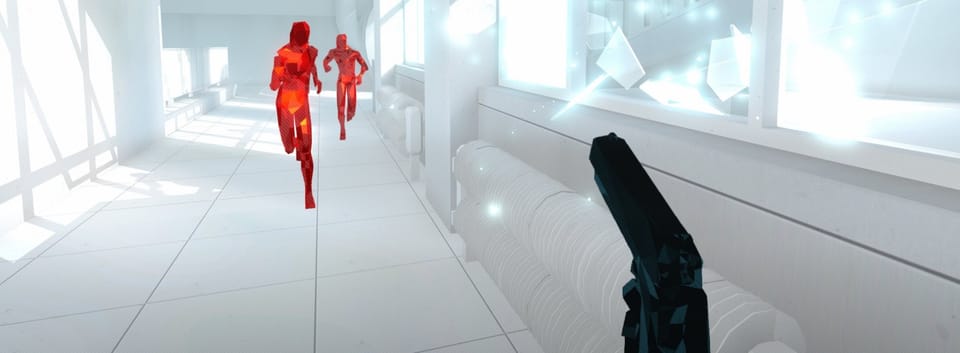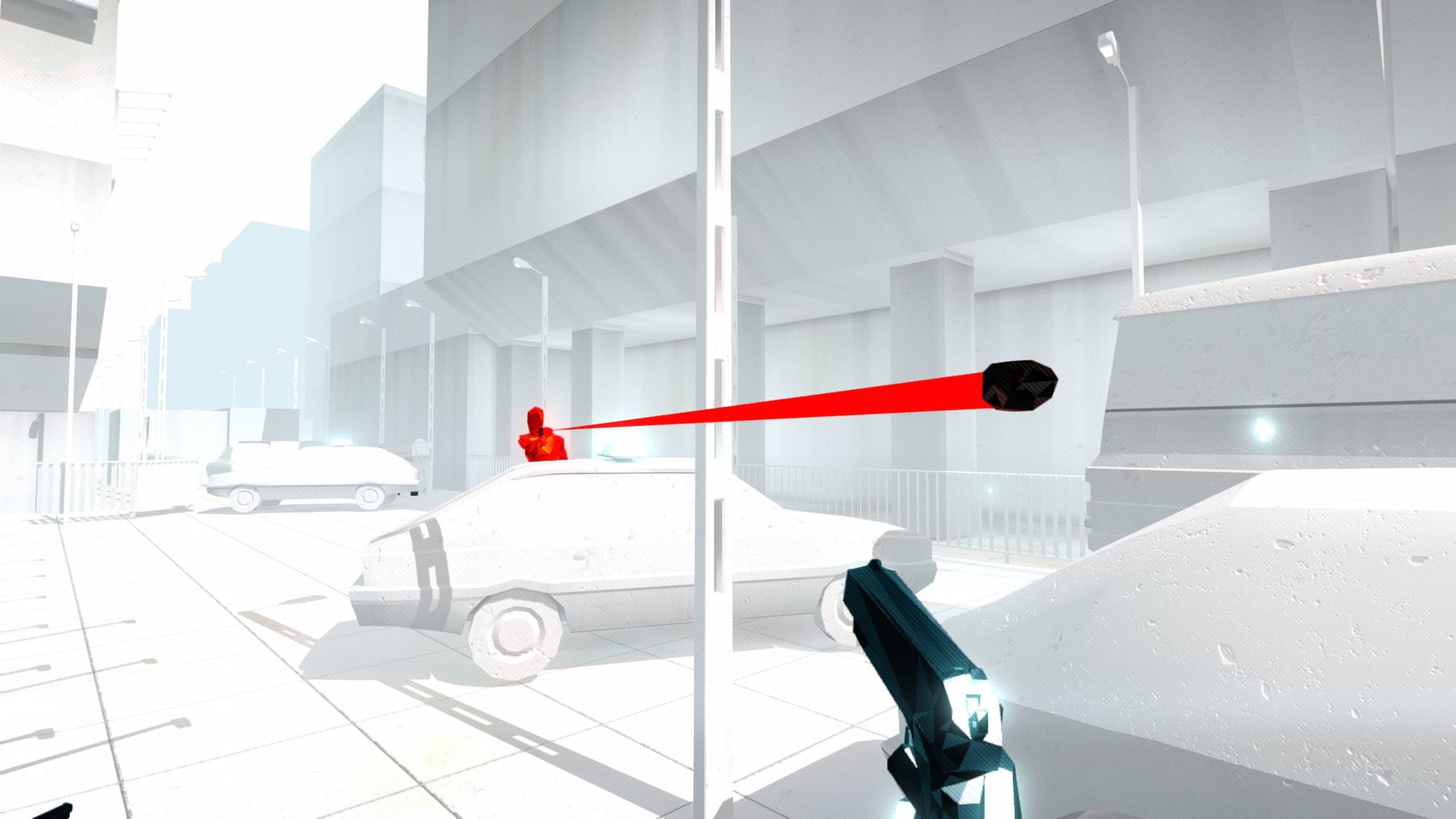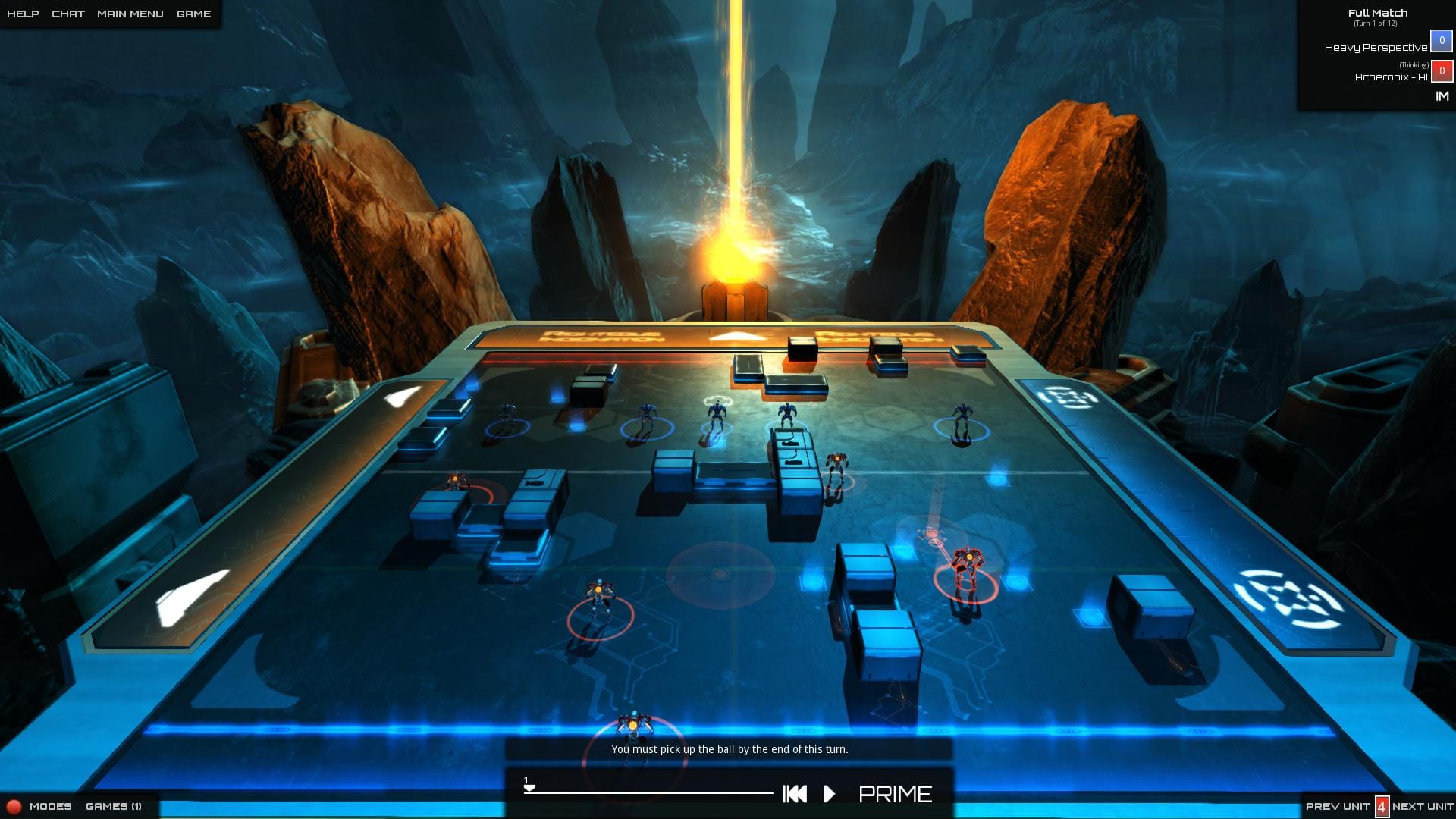SUPERHOT and the unique temporality of videogames

When the Wachowskis transported bullet-time over from Hong Kong cinema to The Matrix (1999), mainstream western audiences were wowed. This was the beginning of something new for action cinema, the ability for the camera to pivot around action, playing a moment from a multiplicity of angles that stunned and awed in equal measure. The camera was unhinged from static points, instead echoing the orbital movement of a clock or pendulum.
In the years following, slow-mo sequences in games misguidedly attempted to convert what was so fascinating about that spectacle into something the player could experience. Instead, it only introduced the banality of controlling an avatar in digital treacle. The real key wasn’t the high frames-per-second cameras, but the way the moment was crystallized and played out in multiple facets—the temporality of the situation was toyed with in a new and exciting way.
Many games have toyed with the elasticity of time, but SUPERHOT will perhaps come closest to digging into that curious sense of temporality which goes beyond the manipulation of the speed of time. In SUPERHOT, you fire bullets that tear vivid red scars through the interiors—austere, wiped-clean renditions of office architecture that are only a side-step from that famous Matrix Lobby scene. The speed of the game world is linked directly to your character’s motion, like a twitchy editor you scan the game speed forward in lurches or staccato beats. Bullets move primarily when you move, otherwise they hang in bizarre abstracted webs and patterns, cutting up the frame as they dissect the screen.
like a twitchy editor you scan the game speed forward in lurches or staccato beats
It’s been a curious experiment since 2013, soon to be a full-fat game, but it beckons towards something that only games can do with any real sense of agency: the power to alter the flow of time in various ways, something that is impossible within the confines of real-life. Time is a highly abstracted concept, perhaps one that is perceived only because we need it to be. Frank Kermode’s book The Sense of An Ending (1967) talks about how we are obsessed with quantifying time, demarcating it. Through religions, societies became obsessed with eschatological events, all for for the sake quantifying time, making moral decisions seem like they had impact due to a definitive end date and a guaranteed meeting with their maker.
As a species, this is frequently reflected in our art, even in the most basic structural premise of the ending: books end, films end, songs end. That isn’t to say temporality escapes subversion in these mediums. If anything, the constraints of physical mediums have encouraged artists to toy with temporality in bizarre ways. This happened most notably during the modernist period in literature, during which writers such as Woolf, Joyce, Ford, and Faulkner all wrote with a keen eye focused on the issue of presenting the moment as a reality on the page.
Instead of being able to guide a reader through a warped knot of plotting that obfuscated the narrative time, they instead focused on the experience of time itself. In Mrs. Dalloway (1925), the narrator ducks and weaves through the consciousness of multiple peripheral characters as they all experience the retort from a backfiring car, or their perceptions of a skywriting plane. In the text, this allows Woolf to bat the reader between the fractured, shell shocked mind of Septimus and the cluttered reminiscences of Mrs. Dalloway. Dorothy Richardson and subsequently James Joyce each attempted to capture all the minutiae of a day within one book, crafting the tomes Pilgrimage (1914-1938) and Ulysses (1922) respectively, but still kept in that free-associative feeling, that any instant in human perception could careen off into another lateral thought or moment.

Games that play with time, like SUPERHOT, translate that desire to explore a moment into a mechanical foundation. The lazy vectors of bullets precipitate a multitude of responses—specific approaches force the player to decide how and where to spend their time, knowing that each step taken will accelerate the trajectory of bullets, narrow certain opportunities and present others. The shared moment between player and AI is an interlocution of bullets and trajectories. Time and thought is reduced to a shared focus on those angles of impact and response, with the player’s agency providing such a multiplicity of responses that no other entertainment could hope to replicate the almost fractal nature of the action.
If time is an artificial construct in our existence, then digital time is doubly so. How time passes in games is unique to the hardware, the system clock usually being the anchor for all progression, with coded artifice creating a digital world that allows the simulation of time in a way that makes sense to the player. While games frequently have narratives that subvert the A-B conventions of chronological time, their main differentiating factor from film and literature is the ability to make the use of time as a tool or commodity that can be toyed with in a way that is beyond our ability in the physical world. SUPERHOT’s metered out instances allow the player to demarcate their own portions of strategic time: but importantly they can never go backwards. Braid (2008) offered a number of ways to alter time (with certain levels mirroring SUPERHOT’s convention) and rewinding to find solutions was par for the course.
the constraints of physical mediums encourages artists to toy with temporality
In Braid, creator Jonathan Blow tells us that this is a closed system the game cannot be rewound past its point of conception—which matches the limits placed upon Link in The Legend of Zelda: Majora’s Mask (2000). Time can only be toyed with to a certain degree, as it begins to abstract cause and effect beyond the limitations of a computer simulation. Despite this, Majora’s Mask and Braid both show us how time in games can be fluidly altered, either by hopping forwards and backwards through it, or by increasing or decreasing its passage to create an effect. This is something ultimately impossible in traditional media, where our actual perception of events is not changed; passages and scenes can be repeated, but there is no autonomy.
Still, the repetition of the day’s events in Majora’s Mask helped to create a highly detailed microcosm of quotidian activity. Few games delve into the network of day-to-day life as heavily as Majora’s Mask, with the intimacy of people’s schedules revealing themselves to players as they learn them by rote. Inamura and his team created a network of layered interactions similar to those created in Modernist novels, but with the player fulfilling the function of author within remit of the text, jumping back and forwards to fill in blanks, carefully altering events to steer storylines in favorable contexts. Curiously, Majora’s Mask still fulfills Kermode’s assertion of the obsession with the eschatological, with the game centered around the fall of the moon on the city, reinforcing the fact that toying with time in narrative games still needs to be organised around a firm teleological point.
Even games that profess to have little to do with ‘time manipulation’ as a mechanic reveal echoes with texts that explicitly state it. Mode7’s realtime strategy (a curious term considering little game-time is truly ‘real’ or mapped to real time 1:1) games Frozen Synapse (2011) and Frozen Cortex (2015) explore the idea of agonising over a single moment for as much time as a player can stomach or afford. While Synapse is overly fussy in its detailed controls of human drone combat, Cortex instead prefers a simpler system that is nonetheless robust enough to draw players into endless iteration on simple actions inside the parameters of team-based future sport.

With its matches divided into short handfuls of time, the planning phase allows a player to move both theirs and their opponent’s team of robots around the play area, performing dry runs of plans. Tiny fractional differences in stopping distances and movements can result in huge differences in outcomes—a missed tackle or pass, a poor stab at guessing a player’s movement—which leads to obsession and tinkering in these plans over and over. The 30-second play time can then be broken up by hours of plotting individual moments over and over, in such detail and multiplicity that it recalls the literary devices used by Woolf and Joyce to explain the mental state of a conscious human in time. In much the same way that these authors compartmentalized moments in time and delivered them to readers, so too do the two players deciding on the best iteration of a few short moments. It leads to entirely different interpretations of situations that isn’t possible within the format of twitch-heavy occurrences of other synchronous videogame competition. The way these interactions then free-associate into a network of call and responses that can be endlessly pored over is tied explicitly to the game’s combination of overt planning, encouragement of iteration, and the real-time simulation of disparate ruminations.
And it is these curious temporal knots that make videogames unique. They function in ways that a novel or a film struggle to achieve, allowing a player to construct their own Groundhog Day (1993) style scenarios. They are in control of the iterative looping, finding their own points of interest and potential to alter time. This year’s Oxenfree comments lightly on this, by alluding to branching narratives and multiple end states. To achieve this, the ending is structured in such a way that it invites the player to play the game again and again to try and fix what looks like a less than optimal outcome—one that is linked to the time loops that beset the characters as they attempt to progress. Adding to the encouragement, the game even goes so far as to allow players to record choices that will appear in another player’s game, and it also breakdowns of all a player’s outcomes (as Telltale does in its adventure games), as if suggesting there were some hidden combination that might finally allow the narrative to change. In the end, the narrative cannot be corrected, the denouement and its results are always fixed from the beginning. The hint of some ultimate ‘correct’ solution instead speaks of the strange conceit of playing a game with branching narratives again to try and alter the outcome. When all’s said and done, Oxenfree is less concerned with the destination, but the experience of travelling, with its nested time loops echoing the player’s limited agency. It’s an idea that finds strange kinship in the futility of Dark Souls (2011) narrative; a game that throws notions of temporal structure to the wind with its half-forgotten legends and shifting, phasing timelines that allow its cyclical plot to continue without end.
games provide the ability to have a conversation with the fabric of existence
With these time-altering tricks, games place themselves within a canon of art that is dedicated to exploring a concept that at once defines and defies human existence. Perhaps stereotypically they are often overly concerned with packaging these explorations into mechanical devices, focusing on how time manipulation can alter play, as opposed to toying with time for reasons beyond the participatory—John Cage’s 639-year-long musical piece As SLow aS Possible is a prime example of something that exists on the very limits of participation.
Nevertheless, these temporal conceits in games speak to something atavistic. The ability to have a conversation with the fabric of existence is something that videogames can provide, and it is an experience that the agency of gaming makes possible in a way that other mediums cannot. Games do not simply comment on the construction of time, they allow people to twist, stretch, compress, replay and manipulate time in a way that allows a glance at the abstracted concepts that lie behind the ineffable machinations of existence.



